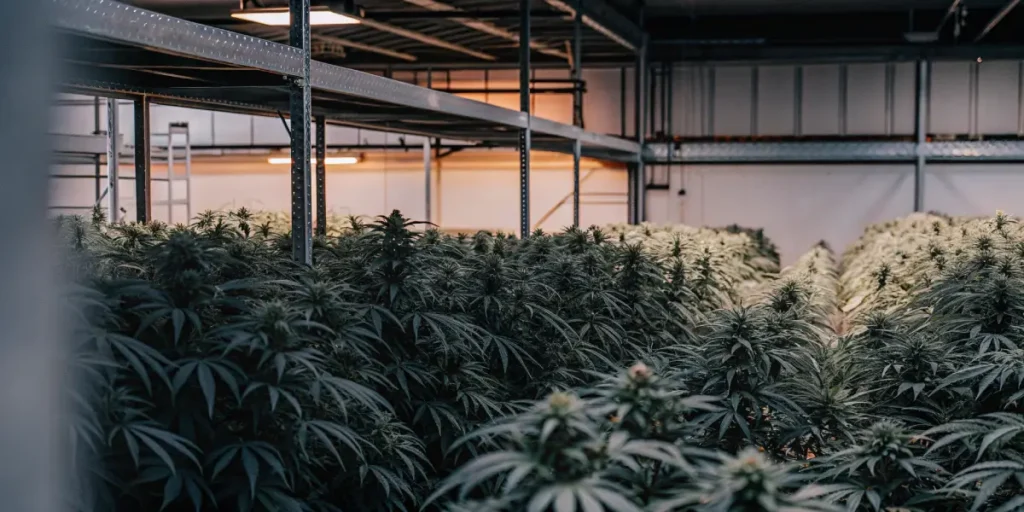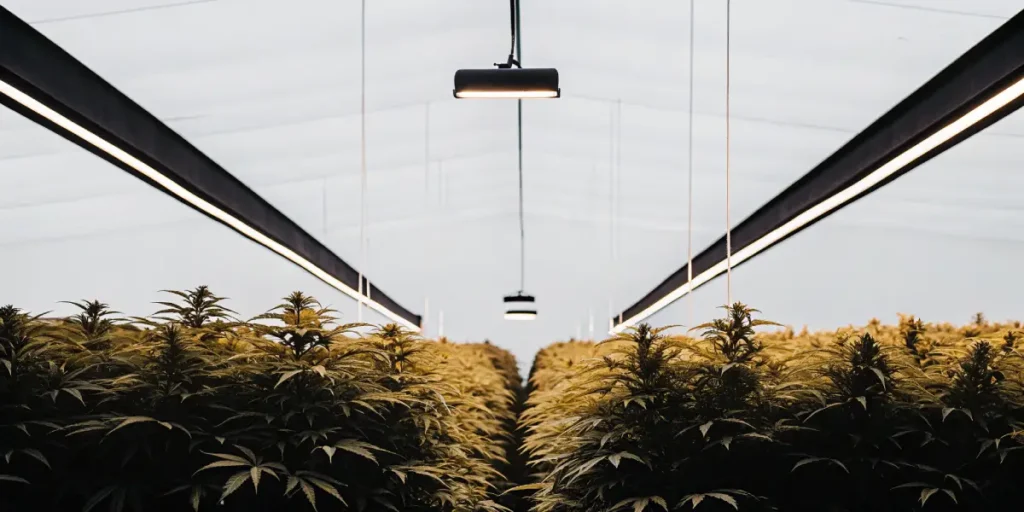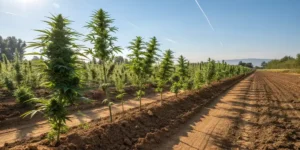Every grower dreams of achieving boosted cannabis yields. Whether you’re just starting out or have years of experience, increasing your harvest can be both rewarding and profitable. The trick is to fine-tune your growing methods and choose the right cannabis strains.
Choosing the right strain is the first step. Some strains naturally produce higher yields, and Global Green Genetics offers a variety of options. For example, the “Big Bud” strain is famous for its large flowers and impressive yields. Another high-yielding option is “Critical Mass,” known for its dense buds and heavy harvests.
Once you’ve selected your seeds, it’s time to focus on your growing environment. Whether you’re growing indoors or outdoors, the conditions you provide will impact your final yield. Let’s dive into some techniques and tips to help you achieve those boosted cannabis yields.
Best Nutrients for Boosting Cannabis Yields
Supplying your plants with the best nutrients for boosting cannabis yields is crucial for maximizing yields. Nutrients act like food for your cannabis plants, and the right balance can make all the difference. Start with a high-quality base nutrient that provides essential macronutrients like nitrogen, phosphorus, and potassium.
Besides to base nutrients, consider adding supplements that boost growth. Products rich in calcium and magnesium help plants absorb nutrients more efficiently. Brands often offer bloom boosters, which support larger flowers and increased resin production.
- Choose a balanced NPK fertilizer for overall growth.
- Use calcium and magnesium supplements to prevent deficiencies.
- Consider bloom boosters during the flowering stage.
Another critical aspect of nutrient management is monitoring the pH levels of your growing medium. Cannabis plants thrive in a slightly acidic environment, with an optimal pH range of 6.0 to 7.0 for soil and 5.5 to 6.5 for hydroponics. Maintaining proper pH levels ensures that your plants can absorb nutrients effectively, contributing to boosted cannabis yields.
Additionally, it’s essential to tailor your feeding schedule to the specific needs of your plants at different growth stages. During the vegetative phase, focus on providing nitrogen-rich nutrients to support leafy growth. As your plants transition to the flowering stage, shift to a phosphorus and potassium-rich formula to promote bud development. By adjusting nutrient levels based on growth stages, you can enhance overall plant health and yield.
How to Increase Cannabis Yields Indoors
Growing indoors provides control over the environment, allowing for optimized conditions. One way to increase cannabis yields indoors is by carefully managing light, temperature, and humidity. LED lights are particularly effective, as they offer the full spectrum of light that cannabis plants crave.
Temperature control is also vital. Keep temperatures between 70-85°F during the day and slightly cooler at night. Humidity levels should be around 40-50% during the flowering stage to prevent mold and encourage resin production.
- Utilize LED lights for energy-efficient growth.
- Maintain optimal temperature and humidity levels.
- Implement the Sea of Green technique for better light distribution.
Ventilation is another crucial factor in how to increase cannabis yields indoors. Proper airflow helps regulate temperature, remove excess humidity, and prevent the buildup of mold and mildew. Installing oscillating fans and an exhaust system can create a gentle breeze that mimics natural outdoor conditions, promoting healthy growth.
Furthermore, maintaining cleanliness in your grow space is essential for preventing pests and diseases. Regularly inspect plants for signs of infestations and address any issues promptly. Keeping your grow area clean and free of debris minimizes the risk of harmful pathogens and pests, contributing to healthier plants and boosted cannabis yields.

Organic Methods to Boost Cannabis Yields
For those seeking a natural approach, organic methods offer a sustainable way to boost yields. Organic growing relies on natural materials and processes, avoiding synthetic fertilizers and pesticides. Compost and worm castings are excellent soil amendments that improve nutrient content.
Companion planting can also enhance growth. Plants like basil and marigold not only repel pests but also attract beneficial insects that aid in pollination. Mulching helps retain soil moisture and keeps roots cool, which can increase plant resilience.
- Use compost and worm castings to enrich the soil.
- Practice companion planting for natural pest control.
- Apply mulch to conserve moisture and protect roots.
Another effective organic method to boost cannabis yields is the use of mycorrhizal fungi. These beneficial fungi form symbiotic relationships with plant roots, enhancing nutrient uptake and promoting vigorous growth. Incorporating mycorrhizal inoculants into your soil can significantly improve plant health and yield.
Moreover, crop rotation is an essential practice in organic cultivation. By rotating different plant species in your grow area, you can prevent nutrient depletion and disrupt pest life cycles. This practice not only maintains soil fertility but also supports long-term sustainability and increased yields.
Maximizing Cannabis Yields with LED Lights
LED lights have revolutionized indoor cannabis cultivation. They are energy-efficient, produce less heat, and provide a full spectrum of light. Positioning the lights correctly is key; too close can cause heat stress, while too far can lead to stretching.
LED lights should be placed about 12-24 inches from the plant canopy, depending on the wattage. Adjusting the height as plants grow ensures they receive optimal light levels. A timer can automate the light cycle, mimicking natural sunlight patterns.
Investing in high-quality LED lights can pay off with increased yields. Look for lights with adjustable spectrums to tailor the light for vegetative and flowering stages.
- Keep LED lights at appropriate distances to prevent stress.
- Use timers to maintain consistent light cycles.
- Choose lights with adjustable spectrums for different growth stages.
Maximizing cannabis yields with LED lights also involves understanding the importance of light cycles. During the vegetative stage, cannabis plants benefit from 18-24 hours of light per day, while the flowering stage requires around 12 hours of light followed by 12 hours of darkness. This light schedule encourages proper growth and flowering, ultimately leading to boosted cannabis yields.
Additionally, consider using reflectors or light movers to distribute light more evenly across your plants. These tools help ensure that all parts of the canopy receive adequate light exposure, minimizing shadowed areas and promoting uniform growth. By maximizing light distribution, you can enhance overall plant development and yield.
Training Techniques for Higher Cannabis Yields
Training techniques manipulate the plant structure to maximize light exposure and encourage growth. Low-Stress Training (LST) gently bends branches, spreading them out to allow even light distribution. This method is simple and effective for boosting cannabis yields.
Another technique is topping, which involves cutting the main stem to promote bushier growth. This results in multiple colas instead of just a single main one, increasing overall yield. It’s important to top plants during the vegetative stage for the best results.
For more advanced growers, the Screen of Green (ScrOG) method involves using a screen to train branches horizontally. This maximizes light exposure and supports heavy buds, leading to higher yields.
- Use LST to spread branches for better light exposure.
- Top plants early to encourage multiple colas.
- Implement ScrOG for optimal light distribution and support.
Super cropping is another training technique for higher cannabis yields that involves strategically damaging plant stems to encourage stronger growth. By pinching and bending stems, you can enhance nutrient flow and create a more robust plant structure. This technique requires skill but can lead to significant increases in yield.
Moreover, defoliation, the removal of excess leaves, can improve light penetration and airflow within the canopy. By selectively removing fan leaves, especially during the flowering stage, you can direct more energy toward bud development. This practice, when done correctly, can significantly boost cannabis yields by reducing shading and improving plant health.

FAQs
What are the best strains for boosted cannabis yields?
When aiming for boosted cannabis yields, certain strains are known for their high productivity. “Big Bud” is a classic choice, producing large, dense flowers. “Critical Mass” is another top contender, favored for its heavy, resinous buds.
For those looking for a reliable option, “White Widow” offers robust yields and is easy to grow. These strains, available at Global Green Genetics, provide a solid foundation for achieving impressive harvests.
Additionally, “Northern Lights” is a popular strain with a reputation for high yields and resilience. It’s known for its fast flowering time and robust nature, making it a favorite among indoor growers. Another noteworthy strain is “Blue Dream,” which combines high yields with a balanced THC and CBD profile, attracting both recreational and medicinal users.
When selecting strains, consider factors such as climate, space, and personal preference. Each strain has unique growth characteristics, so it’s essential to choose those that align with your growing conditions and goals. By selecting the right strains, you lay the groundwork for achieving boosted cannabis yields.
How do I choose the best nutrients for boosting cannabis yields?
Choosing the best nutrients involves selecting products that provide a balanced mix of macronutrients. Look for fertilizers with a balanced NPK ratio, such as 10-10-10, for overall plant health. During the flowering stage, switch to a formula with higher phosphorus and potassium.
Consider supplements like calcium and magnesium to prevent deficiencies. These are crucial for nutrient uptake and can significantly impact your yield. Always follow the manufacturer’s instructions to avoid over-fertilizing.
It’s also beneficial to explore organic nutrient options, such as compost teas and fish emulsion, which provide a natural source of essential nutrients. Organic nutrients are often gentler on plants and can improve soil health over time, contributing to sustained boosted cannabis yields.
Moreover, take advantage of foliar feeding as a supplementary method to deliver nutrients directly to leaves. This can be particularly effective during the vegetative stage, providing an extra boost to plant growth. By carefully selecting and applying the best nutrients for boosting cannabis yields, you can optimize plant health and productivity.
Can organic methods effectively boost cannabis yields?
Yes, organic methods can effectively boost cannabis yields while maintaining eco-friendly practices. Using natural soil amendments like compost and worm castings provides essential nutrients without synthetic chemicals.
Organic pest control methods, such as companion planting, help protect crops while enhancing growth. These approaches not only improve the health of your cannabis plants but also contribute to a sustainable growing environment.
Incorporating beneficial insects, like ladybugs and predatory mites, offers a natural way to control pest populations without harmful chemicals. These insects can help maintain a balanced ecosystem in your grow area, reducing pest-related stress on your plants.
Additionally, using organic mulches, such as straw or wood chips, can improve soil structure and moisture retention. These mulches break down over time, adding organic matter to the soil and promoting overall soil health. By focusing on organic methods to boost cannabis yields, you can achieve sustainable and productive cultivation.
What are the benefits of using LED lights for cannabis cultivation?
LED lights offer numerous benefits for cannabis cultivation, including energy efficiency and reduced heat output. They provide a full spectrum of light, promoting healthy growth and higher yields.
LEDs allow precise control over the light spectrum, which can be adjusted for different growth stages. This flexibility leads to boosted cannabis yields and healthier plants overall.
Another advantage of LED lights is their long lifespan, reducing the need for frequent replacements and lowering operational costs. This durability makes them a cost-effective option for both small-scale and commercial growers seeking to maximize profits.
Moreover, LED lights are environmentally friendly, consuming less electricity and producing minimal heat. This helps maintain optimal growing conditions without the need for extensive cooling systems, further enhancing their appeal as a sustainable choice for maximizing cannabis yields with LED lights.
How do training techniques like LST and topping increase yields?
Training techniques such as Low-Stress Training (LST) and topping increase yields by optimizing plant structure for light exposure. LST involves bending branches to create an even canopy, ensuring all parts receive adequate light.
Topping encourages bushier growth by cutting the main stem, resulting in multiple colas. These methods improve light penetration and airflow, leading to healthier plants and higher yields.
By employing training techniques for higher cannabis yields like LST and topping, you can manipulate the plant’s growth pattern to suit your grow environment. This level of control helps maximize space and light utilization, crucial factors for achieving boosted cannabis yields.
Furthermore, these techniques promote stronger stems and branches, capable of supporting heavier buds during the flowering stage. This structural reinforcement reduces the risk of plant damage and enhances overall yield potential. By applying these training techniques, growers can significantly improve their cannabis harvests.





